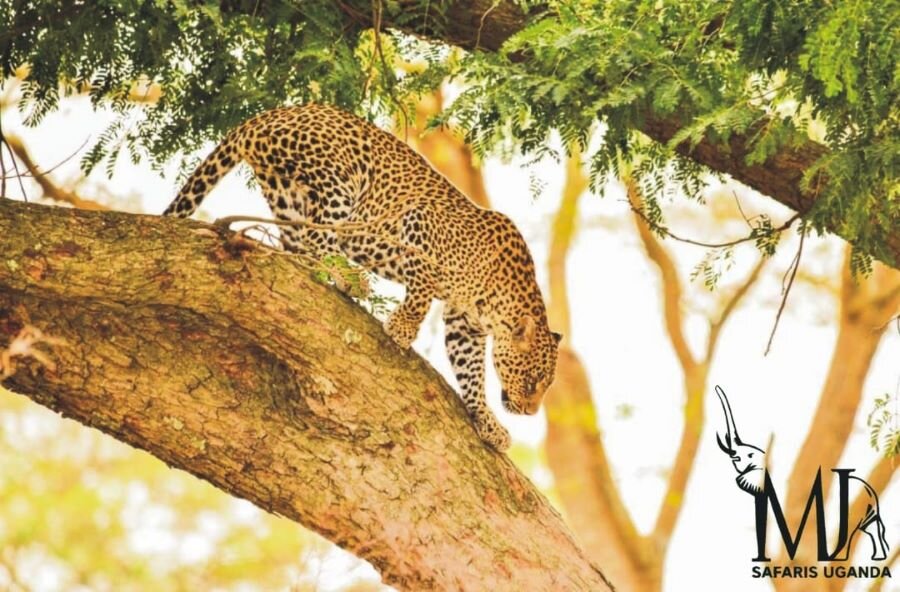
Wanderlust Travel Magazine: live webinar answering FAQs about Uganda safaris, gorilla vs. chimp tracking, where to see the Shoebill in Uganda, self-drive vs. guided tours…
I had to pinch myself when travel expert Mr Philip Briggs asked whether I’d have time to talk live to readers of the famous Wanderlust Travel Magazine. Well, YES! There’s nothing I like better than waxing lyrical about my favourite subject: travel to Uganda!
Wanderlust Travel Magazine “More than 300 of you tuned into our Uganda event to hear Charlotte Beauvoisin, writer of the award-winning blog Diary of a Muzungu, speak live from this incredible country alongside other expert speakers and the Uganda Tourism Board. We learned all about Uganda’s incredible wildlife and fascinating culture.
Featured image of leopard in tree. PHOTO by Peter Hogel. Courtesy MJ Safaris Uganda.

Scroll down to watch the – very lively! – recording “to explore the unspoiled and wildlife-filled landscapes of Uganda. During this virtual evening of travel, we will be meeting the experts who will bring to life the huge biodiversity, local culture and space for adventure in this incredible part of the world.”
Where was Charlotte talking from?
“I was talking live from Kyaninga Lodge a high-end lodge near Fort Portal and Kibale Forest in western Uganda (a good base for chimp tracking).”
Can you drive yourself around Uganda or is it easier to hire a driver?
“Self-drive holidays in Uganda are possible but not recommended if you haven’t done an African road trip before. We always recommend having a driver guide. They know every road – and pothole! They will tell you what time you need to leave your lodge for your next activity, maintain your vehicle and generally be a really good addition to your experience of Uganda. Ideally hire a trained guide with expertise in your particular interest e.g. safari, birding, culture, etc. If you do choose to self-drive, don’t drive at night. Very few roads are lit so driving can be dangerous. I frequently take bus trips between Uganda, Rwanda and Kenya. Buses are incredibly cheap but they don’t have the best safety reputation. (Some of them have seatbelts but few ever work). Large buses ply city routes. Between towns, you will need to catch a matatu minivan taxi, which are very cramped.”
Can you self-drive in Uganda’s National Parks?
“Yes it’s possible to drive yourself in Uganda’s National Parks but you must stick to the marked tracks. Failure to do so may result in a cash fine or even eviction from the park. If you travel independently, you will need to have a Uganda Wildlife Authority armed ranger escort, at your (small) cost. Choose the right one, and you will have an expert guide to your Uganda safari. Although the idea of doing your own game drive sounds exciting, local people know exactly where the different wildlife hunts and sleeps. (It’s amazing what you may drive past while looking in the other direction!)”
What budget do you recommend per day, excluding air fares, for a Ugandan safari?
“Options can vary wildly according to the standard of accommodation and the number of people in your group. You generally pay a little more for lodges and hotels inside a National Park. Uganda has a range of accommodation from homestays and campsites to mid-range hotels and luxury lodges with spas and butler service. Daily rate would usually include: 4×4 vehicle (often a minibus van) with English-speaking driver and fuel; accommodation and meals; some activities such as game drives and nature walks (the more expensive gorilla / chimp tracking permits are usually charged extra).
Generally speaking, allow a budget of $200 or more / day to cover all of the above. If opting to stay in high-end lodges, daily rates would start at $450 per person. [Prices estimated April 2022]. For best value, travel in a group of four or more.” Looking for a tour operator? Check out my Travel Directory.
How accessible and reliable is medical care for tourists in Uganda?
“The first thing to remember is to buy travel insurance before you travel to Uganda. It’s easy to access basic medical advice and clinics in Uganda but if you take regular medication, do bring a good supply with you. It can be difficult to access certain medicines outside Kampala, however, you will easily find malaria testing and treatment facilities, for example. Malaria prevention is always better than cure. Minimise health risks by taking antimalarials, sleeping under a mosquito net and alerting your guide or tour company if you are feeling unwell. Drink filtered or bottled water (few tourists complain of stomach upsets in Uganda).
For more serious health issues, you would need to get to a town or even Kampala. Medivac evacuation (by helicopter for example) is available but very expensive. Compared to many countries, Uganda has not been badly hit by COVID-19. Read Uganda travel advice I ignored – my advice on various health and safety issues based on my 10+ years living in Uganda.”
How does chimpanzee tracking differ from mountain gorilla tracking?
They’re big and they’re hairy – but other than that these two great apes are radically different. Mountain gorillas are huge but gentle vegetarians. Chimpanzees are nutters!
Mountain gorillas spend most of their day on the ground, sleeping and farting. Chimpanzees can cover a big range up in the trees. (Yes, ok, they also fart a lot!)
Gorilla tracking is amazing because of the rainforest territory and the climb through the mist to find them. Chimp tracking is hilarious – they are so like us. (Or are we like them?)
I love both primate tracking experiences. I can’t say one is better than the other but price is definitely a consideration. In 2022 in Uganda, it costs $700 for a gorilla tracking permit. By comparison, a chimp tracking permit is between $50 to $200, depending which National Park or Forest Reserve you track in. Read the Uganda Wildlife Authority’s conservation fees for tariff for 2022- 2024.
Where is the best place to see giraffe and elephants in Uganda?
“The best place to see (Rothschild’s) giraffe would definitely be Murchison Falls National Park. Smaller populations have been reintroduced to Lake Mburo and Pian Upe Wildlife Reserve; you can also see giraffes (and cheetah and a lot more) in Kidepo, in Uganda’s remote north east. Elephant can be easily seen in the popular Queen Elizabeth and Murchison Falls National Parks.”
How easy is it to see the Shoebill bird in Uganda?
“I once saw three Shoebills on the Delta boat ride in Murchison Falls National Park. Their size makes them easy to spot but they are shy and very few in number. Make sure you have an expert guide. If you absolutely have to see the Shoebill – and time or budget are an issue – why not pass by Uganda Wildlife Education Centre in Entebbe? In addition to the Shoebill, you can see indigenous species such as elephant, lion, white rhino, chimpanzee and serval cats. Another location that is an easy drive from Entebbe is Mabamba Bay. Although the Shoebill can be viewed in other parts of Uganda, the places listed here are Uganda’s most popular Shoebill viewing destinations.”
What is the one experience or one place in Uganda that people should experience?

“Murchison Falls National Park in northern Uganda is the country’s most popular National Park (yet for all that, there are few tourists compared to many of Africa’s tourist areas). The park is named after the dramatic falls where the River Nile narrows from 1/2 a kilometre wide to just seven metres wide and plunges 43 metres. It’s a fantastic sight, seen from below via boat or from above: at the Top of the Falls, you can feel the power of the water in the rocks beneath your feet. I write about it in Stirring up magic at the Devil’s Cauldron, Murchison Falls. Murchison is an excellent safari destination, whether for game drives, safari boat rides, birdwatching or chimp tracking in Budongo. The Shoebill is one of Murchison’s 400+ bird species.”
Watch the full recording of the Wanderlust reader event: go wild in Uganda
What did Wanderlust readers have to say about the Go Wild in Uganda webinar event?
Thanks all. Now looking at a trip.
Thanks very much. It’s been a great evening. Great words from great people. Thanks very much to Charlotte and your friends, good job.
Thank you for a wonderful evening. It reminds us of the great time we had in Uganda (and that was without seeing the gorillas as we felt we weren’t fit enough for the trek). It also made us want to go again.
Thank you for a fascinating insight into Uganda. I really enjoyed the event and would love to visit there!


























To tell the truth, wildlife is immense and I think that it is so important to explore it, expanding your mind. I can say that all animals are so unique and it is really important to see their distinctive features. I really like the comparison of a chimpanzee and a mountain gorilla because they have such special factors that distinguish them from each other. I really like chimpanzees because of their interesting visual component and ability to express emotions. It is so funny that chimpanzees have their own, widely understood spirituality and they are interested in other animals, treating them with respect. I would really like to visit Murchison Falls National Park in northern Uganda because, from my point of view, it has an absolutely unique concept and has many impressive things to observe. I think that this park combines all that is necessary to spend time in a non banal way and get closer to nature, feeling a special connection with it.
Do chimpanzees treat other animals with respect? (I don’t think a black-and-white Colobus monkey would say that… they are sometimes preyed on by chimps…)
Chimpanzees are incredible creatures. I often hear them from my home on the edge of Kibale National Park.